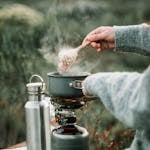When it comes to camping, one of the most important aspects to consider is keeping your food fresh. Proper food storage is crucial to ensure that you and your fellow campers stay healthy and avoid any foodborne illnesses. The last thing you want is to ruin your camping trip with a bout of food poisoning. In this article, we will discuss the risks of food spoilage and foodborne illnesses, and provide tips on how to keep your food fresh while camping.
Food spoilage occurs when bacteria, molds, or yeasts grow on food, causing it to become unsafe to eat. This can happen when food is not stored at the proper temperature or when it is exposed to air, moisture, or other contaminants. When camping, it can be challenging to maintain the ideal conditions for food storage, as you don’t have access to a refrigerator or freezer. However, with the right cooler and proper packing techniques, you can keep your food fresh and safe to eat throughout your camping trip.
Foodborne illnesses are caused by consuming contaminated food or beverages. Symptoms can range from mild stomach discomfort to severe vomiting and diarrhea. The most common causes of foodborne illnesses are bacteria such as Salmonella and E. coli, which can grow rapidly in warm temperatures. By keeping your food properly chilled in a cooler, you can prevent the growth of these harmful bacteria and reduce the risk of foodborne illnesses.
Choosing the Right Cooler: Features to Look For
When it comes to choosing a cooler for camping, there are several factors to consider. The first is the type of cooler you want to use. There are two main types of coolers: hard-sided coolers and soft-sided coolers.
Hard-sided coolers are made of durable materials such as plastic or metal and offer excellent insulation. They are more expensive than soft-sided coolers but provide better temperature control and can keep your food cold for longer periods of time. Soft-sided coolers, on the other hand, are made of flexible materials such as fabric or nylon. They are lightweight and easy to carry but do not offer the same level of insulation as hard-sided coolers.
When choosing a cooler, look for features such as insulation thickness, airtight seals, and sturdy handles. Thicker insulation will provide better temperature control, while airtight seals will prevent warm air from entering the cooler. Sturdy handles are essential for easy transportation, especially if you have a heavy cooler filled with food and drinks.
Packing Your Cooler: Tips for Maximum Efficiency
Properly packing your cooler is essential for maximizing space and keeping your food organized. Here are some tips to help you pack your cooler efficiently:
1. Pre-chill your cooler: Before packing your cooler, pre-chill it by filling it with ice or ice packs for a few hours. This will help lower the temperature inside the cooler and ensure that your food stays cold for longer.
2. Use ice blocks or frozen water bottles: Instead of using loose ice cubes, use larger ice blocks or frozen water bottles. They will melt more slowly and keep your food colder for a longer period of time.
3. Separate perishable items: Keep raw meat, poultry, and seafood separate from other foods to prevent cross-contamination. Place them in leak-proof containers or sealed plastic bags to avoid any potential leaks.
4. Pack in layers: Start by placing a layer of ice or frozen items at the bottom of the cooler. Then, add a layer of food, followed by another layer of ice or frozen items. Repeat this process until the cooler is full, making sure to leave some space at the top for additional ice.
5. Keep frequently used items on top: Place items that you will need frequently, such as drinks or snacks, on top of the cooler for easy access. This will prevent you from having to dig through the cooler every time you want something.
6. Use dividers or baskets: To keep your food organized and prevent it from getting crushed, use dividers or baskets inside the cooler. This will help separate different types of food and make it easier to find what you need.
Preparing Food for Cooler Camping: What to Cook Ahead of Time
| Grilled Chicken | 10 minutes | 15 minutes | 30 minutes | 3-4 days |
| Roasted Vegetables | 10 minutes | 25 minutes | 30 minutes | 3-4 days |
| Quinoa Salad | 15 minutes | 20 minutes | 30 minutes | 3-4 days |
| Hard Boiled Eggs | 5 minutes | 10 minutes | 15 minutes | 1 week |
| Pasta Salad | 10 minutes | 10 minutes | 30 minutes | 3-4 days |
To make your camping trip more enjoyable and stress-free, it’s a good idea to prepare some of your meals ahead of time. This will save you time and effort at the campsite and ensure that you have delicious and nutritious meals ready to go. Here are some ideas for meals that can be cooked ahead of time:
1. Marinated meats: Marinate chicken, beef, or pork in your favorite marinade and freeze them in sealed plastic bags. This will not only infuse the meat with flavor but also help keep it fresh in the cooler.
2. Pre-cooked pasta or rice: Cook a large batch of pasta or rice and store it in airtight containers. These can be used as a base for various dishes such as pasta salads or stir-fries.
3. Pre-cut vegetables: Chop up vegetables such as bell peppers, onions, and zucchini and store them in sealed containers or bags. These can be used for salads, stir-fries, or skewers.
4. Pre-made sauces and dressings: Make your favorite sauces and dressings ahead of time and store them in small containers. This will save you time and effort when preparing meals at the campsite.
5. Pre-assembled sandwiches or wraps: Make sandwiches or wraps ahead of time and wrap them tightly in plastic wrap or foil. These can be enjoyed as a quick and easy lunch option while camping.
By preparing some of your meals ahead of time, you can spend less time cooking and more time enjoying the great outdoors.
Storing Food in the Cooler: Best Practices and Organization
Properly storing food in your cooler is crucial for maintaining its freshness and preventing cross-contamination. Here are some best practices for storing food in the cooler:
1. Keep raw meat separate: As mentioned earlier, it’s important to keep raw meat, poultry, and seafood separate from other foods to prevent cross-contamination. Place them in leak-proof containers or sealed plastic bags and store them on the bottom of the cooler to prevent any potential leaks from contaminating other items.
2. Use separate coolers for drinks and food: To prevent frequent opening and closing of the cooler, consider using a separate cooler for drinks. This will help maintain the temperature inside the food cooler and prevent warm air from entering.
3. Store perishable items on top: Place perishable items such as dairy products, eggs, and fresh produce on top of the cooler. These items are more sensitive to temperature changes and should be kept as cold as possible.
4. Keep items tightly packed: Make sure to pack your cooler tightly to minimize air space. This will help maintain the temperature inside the cooler and prevent warm air from entering.
5. Use ice packs strategically: Place ice packs or frozen water bottles strategically around the food items to ensure even cooling. Avoid placing them directly on top of delicate items such as fruits or vegetables, as they can freeze and become damaged.
6. Monitor the temperature: Use a thermometer to monitor the temperature inside your cooler regularly. The ideal temperature for perishable foods is below 40°F (4°C). If the temperature rises above this, you may need to add more ice or adjust your packing to ensure proper cooling.
By following these best practices and keeping your food organized, you can ensure that your meals stay fresh and safe to eat throughout your camping trip.
Keeping Your Cooler Cold: Ice vs. Ice Packs

When it comes to keeping your cooler cold, you have two main options: ice or ice packs. Both have their pros and cons, so it’s important to consider your specific needs and preferences.
Ice is readily available and inexpensive. It can be easily purchased or made at home using ice cube trays or freezer bags. Ice also has a higher cooling capacity than ice packs, meaning it can keep your food colder for longer periods of time. However, ice can melt quickly, especially in warm weather, and can create a mess in your cooler as it melts.
Ice packs, on the other hand, are reusable and mess-free. They are typically filled with a gel-like substance that stays frozen for longer periods of time than ice. Ice packs are also more compact and take up less space in your cooler. However, they can be more expensive than ice and may not provide the same level of cooling capacity.
To maximize the cooling efficiency of your cooler, you can use a combination of both ice and ice packs. Start by placing a layer of ice or frozen water bottles at the bottom of the cooler. Then, add a layer of food followed by ice packs. Repeat this process until the cooler is full, making sure to leave some space at the top for additional ice or ice packs.
To extend the life of your ice or ice packs, keep your cooler in a shaded area and avoid opening it frequently. You can also use insulation blankets or towels to cover the cooler and provide additional insulation.
Alternative Cooling Methods: Solar-Powered Coolers and Portable Fridges
If you’re looking for an alternative cooling method for camping, there are two options worth considering: solar-powered coolers and portable fridges.
Solar-powered coolers are designed to run on solar energy, making them ideal for off-grid camping trips. They are equipped with solar panels that convert sunlight into electricity to power the cooler’s cooling system. Solar-powered coolers can keep your food cold for extended periods of time without the need for ice or ice packs. They are also environmentally friendly and cost-effective in the long run, as they eliminate the need for purchasing ice or ice packs.
Portable fridges, also known as camping fridges or coolers, are designed to run on electricity. They can be powered by a car battery, a portable generator, or a solar panel system. Portable fridges offer precise temperature control and can keep your food and drinks at the desired temperature for extended periods of time. They are more expensive than traditional coolers but provide the convenience of not having to worry about ice or ice packs.
Both solar-powered coolers and portable fridges are excellent options for campers who require long-term cooling solutions or who are camping in remote areas without access to ice or electricity. They offer the convenience of keeping your food fresh and cold without the need for constant monitoring or replenishing of ice.
Maintaining Food Safety: Temperature Control and Hygiene
Maintaining food safety while camping is crucial to prevent foodborne illnesses and ensure that you and your fellow campers stay healthy. Here are some tips for temperature control and hygiene:
1. Keep perishable foods cold: As mentioned earlier, it’s important to keep perishable foods such as meat, poultry, seafood, dairy products, and fresh produce cold. Store them in a cooler with ice or ice packs and monitor the temperature regularly to ensure it stays below 40°F (4°C).
2. Cook food thoroughly: When cooking food at the campsite, make sure to cook it thoroughly to kill any harmful bacteria. Use a meat thermometer to check the internal temperature of meats, poultry, and seafood. The safe internal temperatures are 165°F (74°C) for poultry, 160°F (71°C) for ground meats, and 145°F (63°C) for whole cuts of meat.
3. Practice good hygiene: Wash your hands with soap and water before and after handling food. If running water is not available, use hand sanitizer or wet wipes. Keep your cooking utensils and surfaces clean by washing them with hot, soapy water. Avoid cross-contamination by using separate cutting boards and utensils for raw and cooked foods.
4. Store leftovers properly: If you have any leftovers, store them in sealed containers and keep them cold in the cooler. Leftovers should be consumed within 2-3 days to ensure their safety.
By following these tips for temperature control and hygiene, you can minimize the risk of foodborne illnesses and ensure that your camping trip is a safe and enjoyable experience.
Creative Cooler Meals: Recipes and Ideas for Delicious Outdoor Dining
Camping doesn’t mean you have to sacrifice delicious meals. With a little creativity and preparation, you can enjoy a variety of tasty dishes while camping. Here are some ideas for creative cooler meals:
1. Foil packet meals: Prepare individual foil packets filled with your favorite meats, vegetables, and seasonings. Seal them tightly and cook them over the campfire or on a portable grill. This method allows for easy cleanup and delicious flavors.
2. Mason jar salads: Layer your favorite salad ingredients in a mason jar, starting with the dressing at the bottom and ending with the lettuce on top. When you’re ready to eat, simply shake the jar to distribute the dressing and enjoy a fresh and crisp salad.
3. Campfire nachos: Layer tortilla chips, cheese, beans, salsa, and any other desired toppings in a cast-iron skillet or aluminum foil packet. Place it over the campfire or on a portable grill until the cheese is melted and bubbly. Serve with guacamole, sour cream, or your favorite dipping sauce.
4. Grilled sandwiches: Prepare your favorite sandwich fillings and grill them over the campfire or on a portable grill. Wrap them in foil to keep them warm and enjoy a hot and satisfying meal.
5. One-pot meals: Prepare hearty one-pot meals such as chili, stew, or pasta dishes that can be cooked in a single pot or Dutch oven. These meals are easy to prepare and require minimal cleanup.
By thinking outside the box and preparing meals ahead of time, you can enjoy delicious and satisfying meals while camping.
Cleaning and Storing Your Cooler: How to Keep It in Top Condition
Properly cleaning and storing your cooler is essential for keeping it in top condition and ensuring that it lasts for many camping trips to come. Here are some tips for cleaning and storing your cooler:
1. Empty and rinse: After each use, empty the cooler of any remaining food or ice. Rinse it with warm, soapy water to remove any dirt or residue. Use a sponge or brush to scrub the interior and exterior of the cooler.
2. Disinfect: To disinfect your cooler, mix a solution of one part bleach to ten parts water. Wipe down the interior and exterior of the cooler with this solution, paying extra attention to any areas that may have come into contact with raw meat or other perishable foods.
3. Air dry: Allow your cooler to air dry completely before storing it. This will prevent the growth of mold or mildew.
4. Store with the lid open: When storing your cooler, leave the lid open to allow for air circulation . This will help prevent any moisture or odors from building up inside the cooler. It is also a good idea to clean and dry the cooler thoroughly before storing it to ensure that no bacteria or mold can grow. Additionally, storing the cooler with the lid open can help prolong the life of the seal and prevent any potential damage that could occur from a tightly closed lid.
FAQs
What is a camping cooler?
A camping cooler is a portable container that is used to keep food and drinks cold while camping or traveling. It is designed to keep ice frozen for an extended period of time.
What are the different types of camping coolers?
There are two main types of camping coolers: hard-sided and soft-sided. Hard-sided coolers are made of durable materials like plastic or metal and are more rugged and durable. Soft-sided coolers are made of fabric and are more lightweight and portable.
What size camping cooler should I get?
The size of the camping cooler you need depends on how many people you are camping with and how long you will be camping. A good rule of thumb is to get a cooler that can hold at least one pound of ice per quart of cooler capacity.
How long will a camping cooler keep food and drinks cold?
The length of time a camping cooler will keep food and drinks cold depends on several factors, including the quality of the cooler, the amount of ice used, and the temperature outside. In general, a good camping cooler can keep ice frozen for up to five days.
How do I clean my camping cooler?
To clean your camping cooler, first empty it of all food and ice. Then, use a mild soap and warm water to clean the inside and outside of the cooler. Rinse thoroughly and let it air dry before storing it away.
Can I use dry ice in my camping cooler?
Yes, you can use dry ice in your camping cooler. However, it is important to handle dry ice with care and to follow the manufacturer’s instructions for use. Dry ice can be dangerous if not handled properly.





